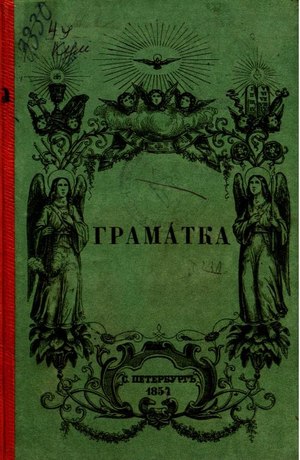Kulishivka
Script error: No such module "AfC submission catcheck".
Kulishivka (Ukrainian: Куліші́вка), also the orthography of Kulish, was a Ukrainian phonetic orthography invented and applied by Panteleimon Kulish in the late 1850s.
All subsequent Ukrainian orthographies were based on Kulish's orthography. In 1923, in his preface to the 5th edition of the Ukrainian Orthographic Dictionary, its editor and one of the authors of the Kharkiv orthography of 1928, Hryhorii Holoskevych, noted that the orthography he used was broadly the same as Kulish's orthography in the 1850s.[1]
General description[edit]
This spelling was used by Kulish in Notes on Southern Rus (vol. 1, 1856) and in Grammar (1857), and then used in the magazine Osnova, published in 1861–1862 in St. Petersburg by Vasyl Bilozerskyi, Nikolay Kostomarov, and Panteleimon Kulish.
Features[edit]

According to this orthographic system:
- Consistently used the letter і to denote the sound /і/ from the early ѣ (літо, сіно, осінь), in place of the early о, є in the newly closed syllables (стілъ, жінка, пічь) and in place of iotated і (Вкраіна, моіх, тихоі). At the beginning of the word the non-iotated vowel was transmitted by the letter и (индик, им'я, Иван).
- The letter ы was removed from the alphabet, and the letter и (синь, лисиця) was used instead to denote the sound /ɪ/.
- In the role of an apostrophe in the middle of words, and at the end of words after consonants the letter ъ was used (пъять, розвъязав, вітеръ, сміхъ).
- The sound /ɛ/ was represented by the letter e (друже, сестра). The letter є used only after soft consonants in middle nouns (весіллє, третє, щастє), and after the vowels — the letter e without noting in the letter the iotation of the sound /ɛ/ (гуляе, думаешь), although the letter є was already in previous spellings. The non-iotated sound /ɛ/ at the beginning of words and after vowels was transmitted by the letter э (Эзоп, поэт).
- The letter ё has been restored for the combinations йо, ьо (ёму, слёзою, тёхнув, народнёго), which are known in ancient orthographic practice.
- The sound /g/ was transmitted by the Latin letter g (дзиga, gуля).
- The letter ѳ was preserved in ancient borrowings from Greek (Коринѳі).[2]
In the spelling of consonants at the junctions of morphemes, Kulish tried to consistently introduce the phonetic principle, imitating in part Oleksii Pavlovskyi, Petro Hulak-Artemovskyi, and others. The verb combination -ться was written through -тьця and -тця (вертаютьця, всміхнетця), and -шся - through -шся and -сся (одібьешся, вітаєсся). In parallel, the prefixes рос- and роз- (роскажуть, розчервонітися). were used.
According to Andrii Danylenko, a Ukrainian-American researcher of the Kulish language, the influence of the Kulishivka on modern Ukrainian spelling was minimal.[3]
Changes[edit]
Some features of the Kulishivka were largely eliminated in the orthography of the South-Western Division of the Russian Geographical Society (1873), co-authored by Pavlo Zhytetskyi and Konstantin Mikhalchuk. On their initiative, the following changes were made to Kulishivka:
- the iotated sound /i/ was first denoted by the letter ї, and the iotated /ɛ/ by the letter є.
- at the end of the word the letter ъ ceased to be used
- the sound /g/ was transmitted not by the Latin letter g, but by the letter combination кг.
In the Russian Empire, kulishivka was used until the Ems Act of 1876. Instead, a spelling was introduced that "would not deviate from the Russian pronunciation of letters." This spelling was called "yeryzhka" (from the letter y - yeri introduced in it), later it was called "yaryzhka". This change in the name was explained by Ahatanhel Krymskyi: "… the word 'yaryzhka' should define something bureaucratic, state, forcibly imposed."
In the 1890s, the Zhelekhivka, which was developed on a similar principle (but it was based on local features of speech), was introduced in schools in Galicia. Instead, in Greater Ukraine, after the expiration of the Ems Act of 1876 in 1905–1914, they began to use Hrinchevychivka, which was a slightly modified Zhelekhivka, in particular in the Dictionary of the Ukrainian Language edited by Borys Hrinchenko.
See also[edit]
References[edit]
- ↑ Hryhorii Holoskevych. Preface // Ukrainian orthography dictionary with short spelling rules. Ed .: Hryhorii Holoskevych. Katerynoslav-Leipzig: Ukrainian Publishing House. 1923. 226 pages. (5th type)
- ↑ ""Кулішівка"". Збруч (in українська). 2018-05-24. Retrieved 2021-01-16.
- ↑ Danylenko Andrii. "Write as you say…", or why Panteleimon Kulish did not become the creator of modern Ukrainian spelling // Linguistics. — 2012. — № 4. — P. 37–54.
External links[edit]
- Кулішівка // Українська мала енциклопедія : 16 кн. : у 8 т. / проф. Є. Онацький. — Накладом Адміністратури УАПЦ в Аргентині. — 1960. — Т. 3, кн. VI : Літери Ком — Ле. — С. 786. — 1000 екз.
- Kulishivka. Ukrainian language. Encyclopedia
- Kulishivka / Izbornyk
- Kulishivka. ESU
- Kulishivka, Internet Encyclopedia of Ukraine
This article "Kulishivka" is from Wikipedia. The list of its authors can be seen in its historical and/or the page Edithistory:Kulishivka. Articles copied from Draft Namespace on Wikipedia could be seen on the Draft Namespace of Wikipedia and not main one.
